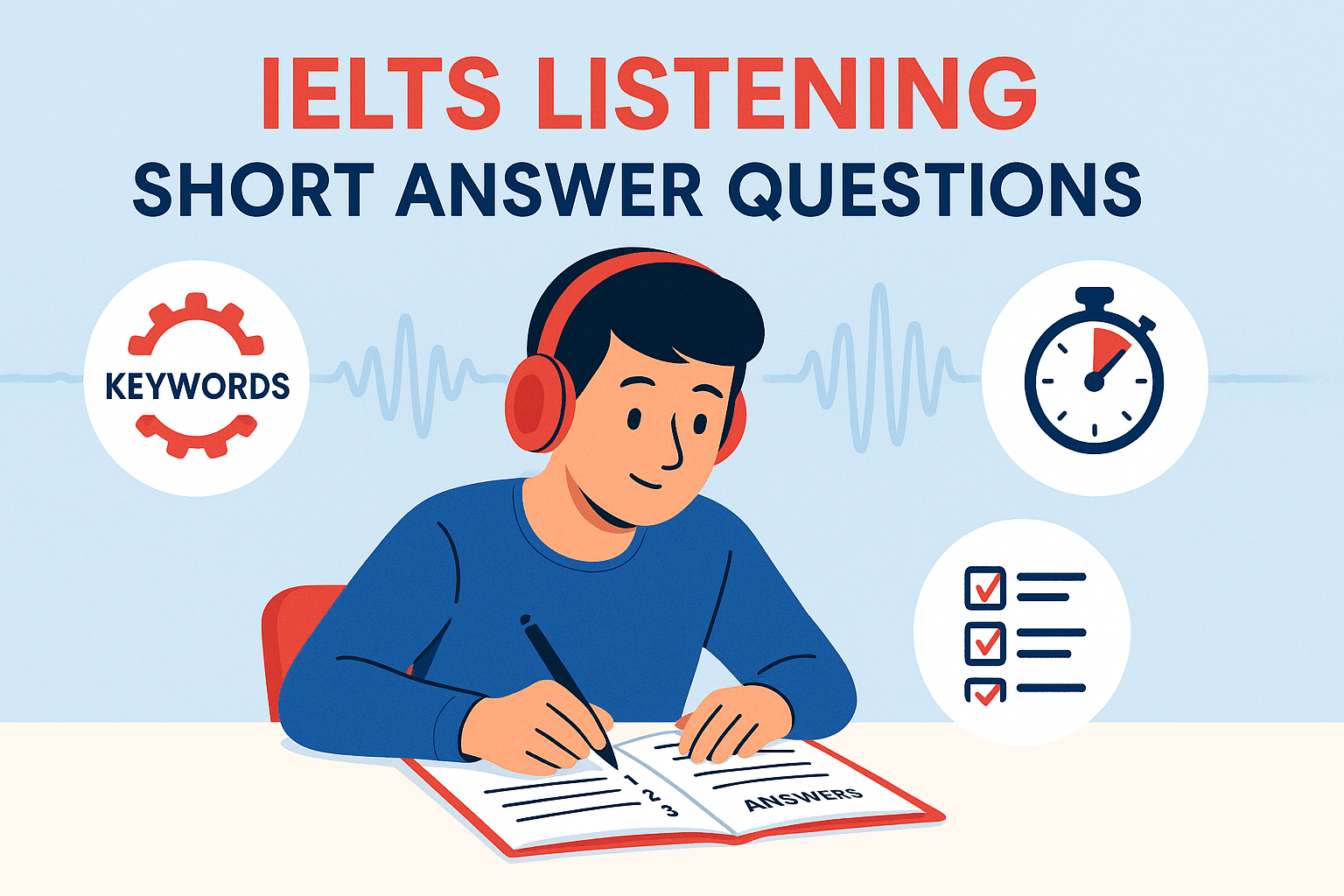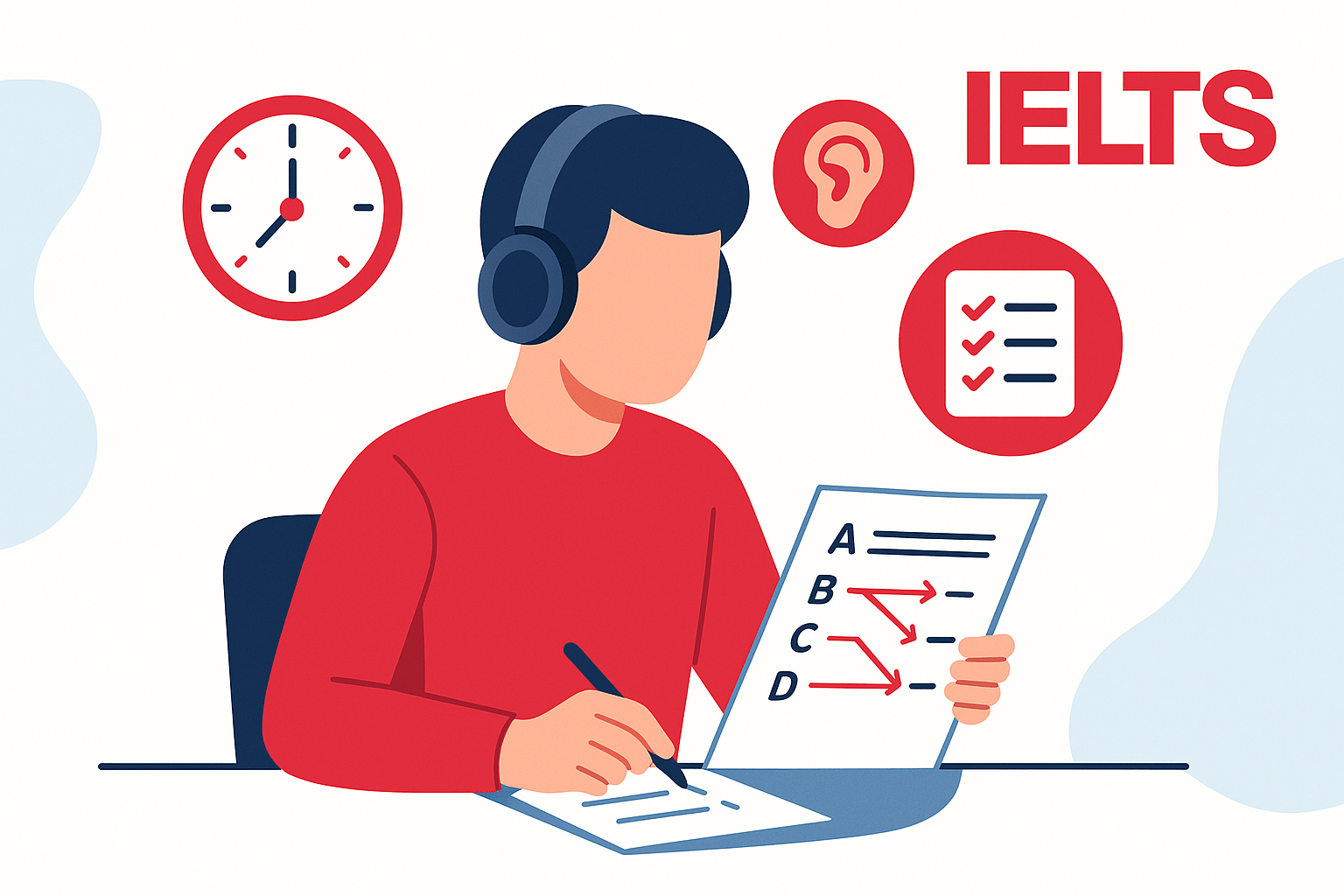- What Is the IELTS Listening Test?
- IELTS Listening Test Format (And Why It Matters)
- Real Student Struggles — and How We Solved Them
- IELTS Listening Test Timing Explained
- How Is the IELTS Listening Band Score Calculated?
- Paper-Based vs. Computer-Delivered: Does Format Matter?
- Pro Tips for Mastering the IELTS Listening Test Format
- Recommended Practice Materials
- Final Thoughts
- FAQ: IELTS Listening Test Format
If you’re aiming for Band 7 or higher in the IELTS Listening section, understanding the IELTS Listening test format is the first—and most overlooked—step to success. As an international IELTS teacher who’s helped students across over 20 countries, I’ve seen a pattern: those who fully understand the test layout often perform better—not because they’re fluent in English, but because they know what to expect and how to prepare.
Let’s break it all down—section by section, with insights, student struggles, and proven solutions I’ve used in real classrooms and online sessions.
What Is the IELTS Listening Test?
The IELTS Listening test assesses how well you can follow spoken English in different real-life contexts. You’ll listen to four audio recordings and answer 40 questions total—10 questions per section.
The entire test lasts around 30 minutes, with an extra 10 minutes to transfer your answers if you’re taking the paper-based test. If you’re doing the computer-delivered version, you’ll input answers as you go, so the extra time isn’t included.
👉 For a more detailed explanation of the timing and transitions between sections, I break it down in this complete timing guide.
IELTS Listening Test Format (And Why It Matters)
Let me walk you through the four parts of the IELTS Listening test, each becoming progressively more challenging. Understanding this format helps reduce stress, anticipate question types, and develop better focus.
Part 1: A Social Conversation
You’ll hear a conversation between two people in a social setting (e.g., booking a hotel or registering for a class).
🔹 Common question types: form completion, note completion, sentence completion.
Part 2: A Monologue in a Social Context
This could be a speech about local facilities, a museum tour, or directions.
🔹 Common question types: labeling a map, matching, short-answer questions.
Part 3: A Conversation in an Academic Setting
Usually involves two to four speakers, like students and a tutor discussing a project.
🔹 Common question types: multiple choice, flowcharts, matching speakers.
Part 4: A Lecture or Academic Monologue
A single speaker talks at length about an academic subject. It’s the most challenging part.
🔹 Common question types: summary completion, sentence completion, table/diagram completion.
For deeper strategies on how to approach each section, I guide you through it in this detailed 4-part Listening guide.
Real Student Struggles — and How We Solved Them
One of my students from Spain, Carlos, consistently lost focus midway through Part 3. His issue? He didn’t understand the transition pattern of the test, so by Part 3, he was mentally exhausted. Once we practiced active listening and signposting—and used techniques from this Band 7–9 strategy guide—his concentration improved, and he hit Band 8 in his next mock test.
Another learner from Vietnam, Linh, always panicked when maps appeared. She assumed she needed to understand everything. But once she realised it’s about locating direction words and predictability, we focused on targeted map-labeling practice using official IELTS materials. That made all the difference.
IELTS Listening Test Timing Explained
Here’s a quick timing overview:
| Section | Audio Type | No. of Questions | Duration |
|---|---|---|---|
| Part 1 | Social conversation | 10 | ~6 minutes |
| Part 2 | Monologue (social) | 10 | ~5 minutes |
| Part 3 | Group academic discussion | 10 | ~5–6 minutes |
| Part 4 | Academic lecture | 10 | ~5–6 minutes |
After all four parts, you get 10 minutes to transfer your answers (paper-based test only).
For more detail on the timeline, read the complete IELTS Listening timing breakdown.
How Is the IELTS Listening Band Score Calculated?
Your band score is based on how many questions you get right out of 40. There’s no negative marking, so always attempt every question!
| Correct Answers | Band Score |
|---|---|
| 39–40 | Band 9 |
| 35–38 | Band 8 |
| 30–34 | Band 7 |
But the real skill isn’t just understanding the format—it’s matching that knowledge with test-day execution. I explain this in more depth in this post on how IELTS Listening scores are calculated.
Paper-Based vs. Computer-Delivered: Does Format Matter?
Absolutely. In the paper-based version, you write answers on paper while listening, then get 10 extra minutes to transfer.
In the computer-based version, you type your answers directly into the system and only get 2 minutes at the end to check.
Both formats use the same audio, question types, and scoring—but your choice depends on your typing confidence and familiarity with computer tests.
Pro Tips for Mastering the IELTS Listening Test Format
- Train your brain to follow native English rhythm — practice with BBC Learning English or IELTS Premium Courses.
- Always read questions before listening. I teach students to scan 5–10 seconds ahead.
- Use prediction strategies — one of the most important tools I teach in my live courses.
- Familiarise yourself with accents — audio includes UK, Australian, New Zealand, and Canadian accents.
- Review your mistakes weekly. Most of my high-band students keep an error log during practice.
Recommended Practice Materials
For mock tests that mirror the actual exam format, check out these IELTS Listening practice tests. They’ve helped many of my students sharpen their timing, strategy, and confidence.
You can also visit the official sites for sample tests and format updates:
Final Thoughts
Understanding the IELTS Listening test format is the difference between guessing your way through and approaching the test with clarity and control. My best students don’t have the best vocabulary—they have the best system.
If you want a full strategy, my Band 7–9 listening guide walks you through how to approach every question type, manage time, and stay focused from beginning to end.
FAQ: IELTS Listening Test Format
Q1: Are all four sections played only once?
Yes, the audio is played just once. This is why prediction and focused listening are key.
Q2: Will I hear different English accents?
Yes. IELTS includes a range of native-speaker accents like British, Australian, and Canadian.
Q3: Can I write answers in all caps?
Yes, IELTS accepts all capital letters as long as spelling is correct.
Q4: Is there a difference between Academic and General Training Listening?
No. Both versions of the IELTS exam use the same Listening test.
Q5: Should I choose the computer-based test?
If you’re comfortable typing quickly and prefer clear on-screen questions, the computer version might suit you. But be aware: you’ll only get 2 minutes at the end to check your work.





3 Responses